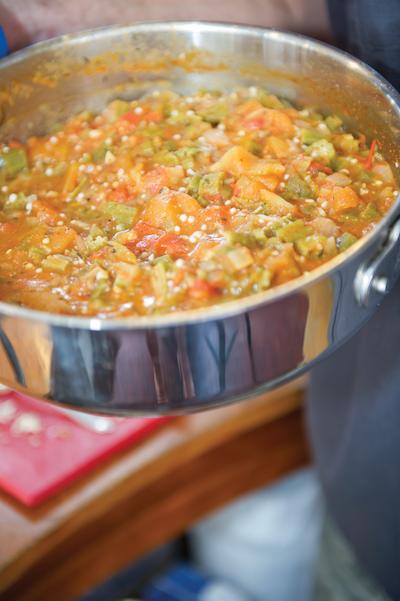“There’s a challenge you can sign up for, called Eat Local, at nolalocavore.org, and when you sign up they give you a lot of information, lists of stuff at farmers’ markets in town, different restaurants and groceries that specialize in locally raised and harvested vegetables. It helps you do your purchasing locally so that you’re putting money back into the local economy, getting fresher ingredients, and also reducing your carbon footprint. When you get vegetables that aren’t in season locally, they have to be driven in, or flown in, or shipped in, across the country and sometimes other countries, and that’s really wasteful when you think about it.
The challenge is that you have to wait for what comes into season. You can’t have tomatoes in the middle of winter. You can’t make a tomato dish, pasta, or whatever you’re used to making, because they’re not in season—unless you planned ahead and put some up during the summer. We’re used to be able to eat anything we want all the time, and that’s not really nature’s way.
Now tomatoes are in season. These are some I picked up at the Hollygrove Market, which is over by Carrollton. They host farmers’ markets on Tuesdays and Saturdays where they bring in farmers from a 200-mile radius. It’s an incredibly good deal. I go there once a week. They have locally raised chicken and beef, cheese and dairy, too, so you can get everything you need.
I made a cornbread earlier in a cast iron skillet. My grandmother used to cook cornbread in her big skillet on the stove. She could flip it like a pancake. I’ve never been able to do it; the whole thing comes apart. So I do it in the oven. She’d make greens or black-eyed peas and a big cornbreadcake. A lot of the times, the cornbread, we’d just crumble it up and put it in with the vegetables. The bread soaks up all the juices and makes a thick stew sort of thing. Don’t look real pretty. I don’t think you’d serve it in a restaurant, but it tastes delicious.
It’s hard to eat strictly locally. Bananas, they all come from Central America, which is a drag, because who doesn’t like bananas? What’s cool about the Eat Local food challenge is they have different levels. There’s the strict, hardcore level, which involves a lot of painful self-denial. The beginner level is a lot easier to get started with. Once you do it, it becomes a habit and that’s the idea. There’s a really good book, called Animal, Vegetable, Miracle, where the author only ate what she produced herself for a year. It involves not being able to eat anything you want all the time, which sounds like a bad thing, but once you get into it, you start eating what’s fresh and what’s local, and you realize how much better it tastes and how much healthier; how much more nutrients are in it. You don’t miss the things you can’t have. Instead, you find cool new recipes and enjoy the food that’s in season more. It forces you to be a little creative. What’s in season stays in season for over a month. So you might be staring at a month of squash. You’ll need more than one recipe.
As a kid, what we had was okra that was just boiled whole, with some salt and garlic powder. It comes out to be this really delicious, slimy, gooey, almost oyster-like thing that you hardly even have to chew, but my girl doesn’t care for it that way. We went around and around about it a few times because I love okra, it’s one of my favorite things, and I had to come up with something different to convince her to eat it. This is what we settled on.
There’s a tendency among cooks to leave out at least one step, or one ingredient. I learned to cook from my grandmother, and I started to notice with my mom—she learned to cook from my grandmother, and I learned from both of them—my mom always leaves out at least one crucial part. Don’t know if she’s just playing a trick on me, but she can’t bring herself to give out all the secrets. There’s always some little thing. ‘How much you put in it?’ ‘Enough.’
What’s up with that?”
Smothered Okra
2 tablespoons olive oil
2 stalks celery, diced
1 small green bell pepper, diced
1 small onion, diced
1 pound okra, sliced
2 cloves garlic, minced
8 tomatoes, cut into large chunks
1 teaspoon Emeril’s Original Essence
1 teaspoon thyme
1⁄2 teaspoon oregano
salt to taste
Heat oil in a wide pan; sauté celery, bell pepper and onion until translucent. Add okra, and keep stirring until the okra “stops stringing,” about 5 minutes. Add as much as 1 cup of water (or chicken broth) as necessary to keep vegetables from sticking to the pan. Add garlic and tomatoes. Simmer, covered, for 10 minutes until tomatoes get mushy. Season with spices, and continue to simmer for about 5 minutes. Serve topped with crumbled cornbread.
[clear]





